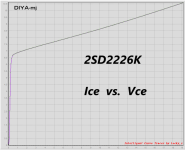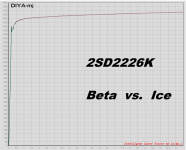Finally got the harness necessary to measure a Rohm 2SD2226K NPN transistor on my little curve tracer. Measured Beta is 1650, slightly higher than the manufacturer-supplied SPICE model's 1350. Measured Early Voltage (SPICE parameter "VA") is 33 volts, about half of the SPICE model's 70V.
My inexpensive tracer starts to poop out at extremely low Ibase, as you can see at the left of the Beta plot. But then it recovers and starts to give reasonable results. Vce is displayed in volts, Ice is displayed in milliamps, Beta is displayed in milliamps per milliamp.
Maybe I'll order some of the other Rohm supertransistors and examine how they behave too (?)
_
My inexpensive tracer starts to poop out at extremely low Ibase, as you can see at the left of the Beta plot. But then it recovers and starts to give reasonable results. Vce is displayed in volts, Ice is displayed in milliamps, Beta is displayed in milliamps per milliamp.
Maybe I'll order some of the other Rohm supertransistors and examine how they behave too (?)
_
Attachments
Elektroj has not been active on the forum for more than 4 years nowThat's Thorenski with SMEnski tonearm.
and his last visit was exactly 2 years ago. Hope all is well on his side ..

